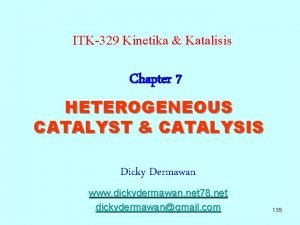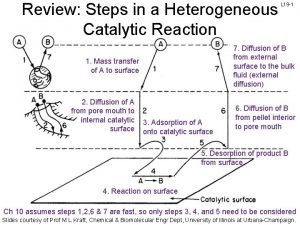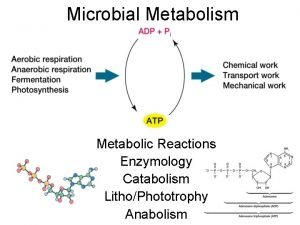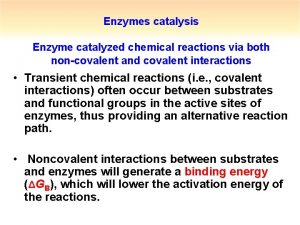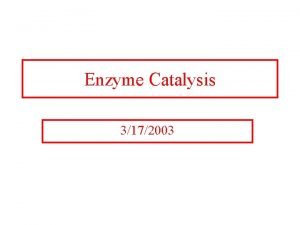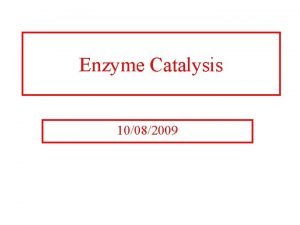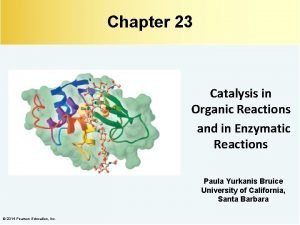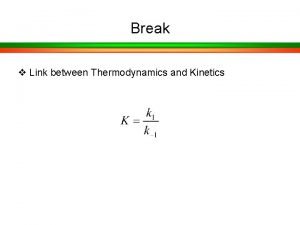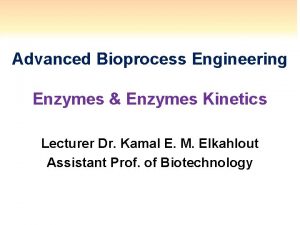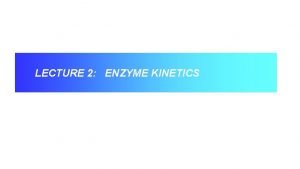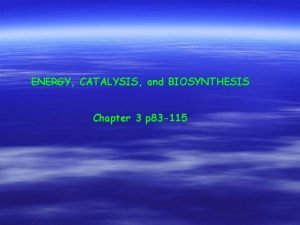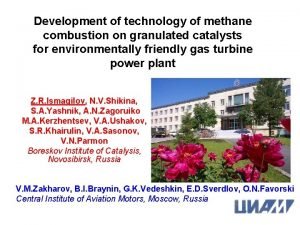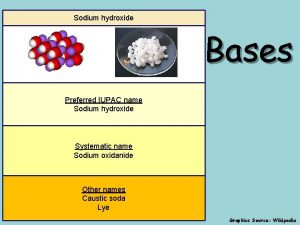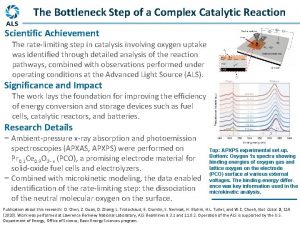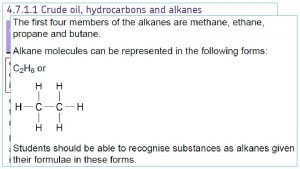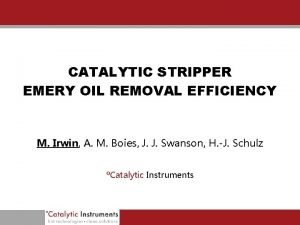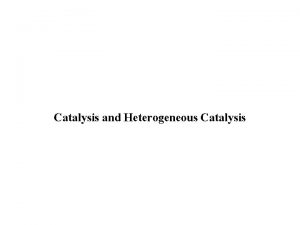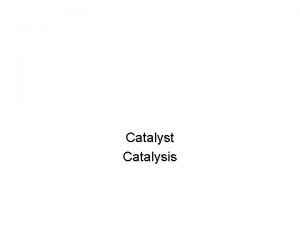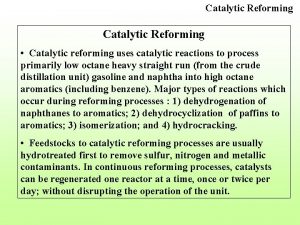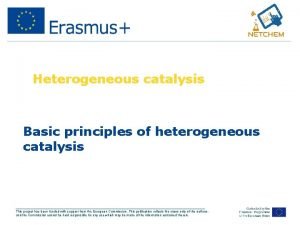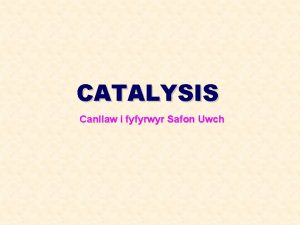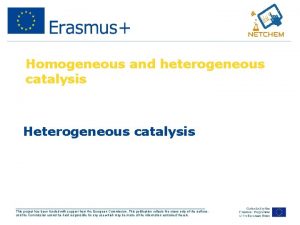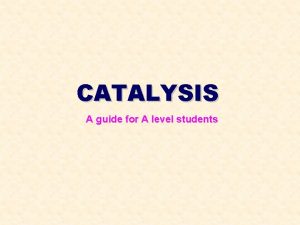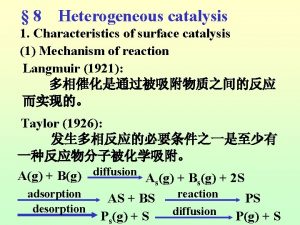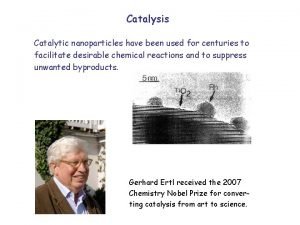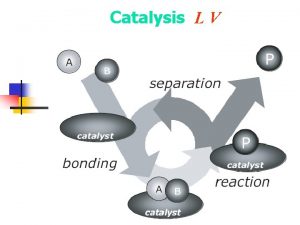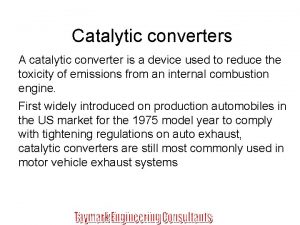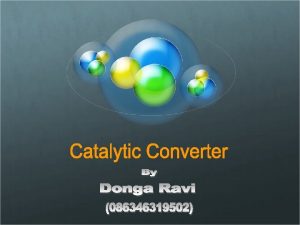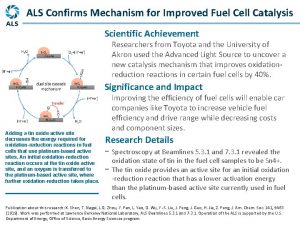2 D material Application in catalysis Catalytic mechanism



















- Slides: 19


目录 • • • 2 D material Application in catalysis Catalytic mechanism Catalysis in g-C 3 N 4 Catalysis with support of TSS(Bi 2 Se 3) Summary

2 D material 两个交替堆叠的六方氮化硼层 石墨烯 Mo. S 2的层状结构 石墨烷 Wikipedia-Two dimensional materials

application in catalysis • 1. Graphene with defects and edges: Oxygen reduction reaction (ORR) in alkaline conditions • 2. Graphene with heteroatoms (such as N, B, S, P, O or metal): Oxygen evolution reaction (OER) in alkaline conditions ORR in alkaline conditions Photocatalytic water-splitting • 3. g-C 3 N 4: Photocatalytic water-splitting Photocatalytic oxidation、 NO decomposition Electrocatalytic water-splitting • 4. 2 D transition metal dichalcogenides : Electrocatalytic HER in acid CO hydrogenation

application in catalysis • 5. 2 D metal crystals (for example Pd, Rh): Electrocatalytic oxidation of formic acid Selective hydrogenation and hydroformylation • 6. 2 D crystal coating on metals: ORR in acidic fuel cells HER in acid conditions • 7. Nanoreactor between 2 D crystals (such as graphene, BN) and metal surfaces: CO oxidation • 8. Sandwich structures based on 2 D crystals: Electrocatalytic HER Nature Nanotechnology 11, 218– 230 (2016)

Catalytic mechanism ①② ③ ④ Fig. 1 Schematic diagram for the photocatalysis mechanism of semiconductor :strong oxidation

Catalytic mechanism Fig. 2 Band edge position for some semiconductor photocatalyst Zn. O、Cd. S :Poor stability Ti. O 2 :strong oxidizing power, high chemical durability, and nontoxicity

Catalytic mechanism Limitation: Large band gap energy : excited in the ultraviolet region Low quantum efficiency : recombination of photo-induced carrier Stability Modification: Selective metal ion doping Deposition of metal particles Heterojunction Surface sensitization

Catalysis in g-C 3 N 4 For an economical use of water and solar energy, catalysts that are sufficiently efficient, stable, inexpensive and capable of harvesting light are required For photocatalysis to be chemically productive, precious-metal species such as Pt and Ru. O 2 must be used in most cases as extra cocatalysts to promote the transfer of photoinduced charge carriers from the bulk to the surface at which water is converted to hydrogen gas Carbon nitrides can exist in several allotropes with diverse properties, but the graphitic phase (g-C 3 N 4) is regarded as the most stable under ambient conditions. Wang X, Maeda K, Thomas A, et al. Nature materials, 2009, 8(1): 76 -80.

The bandgap of the condensed graphitic carbon nitride (g-C 3 N 4) is estimated to be 2. 7 e. V. This bandgap is sufficiently large to overcome the endothermic character of the water-splitting reaction (requiring 1. 23 e. V theoretically) Wang X, Maeda K, Thomas A, et al. Nature materials, 2009, 8(1): 76 -80.

Time courses of H 2 production from water containing 10 vol. % methanol as an electron donor by bare g-C 3 N 4 under visible light irradiation (of wavelength larger than 420 nm) the estimated quantum efficiency of the Pt-modified C 3 N 4 catalyst is still rather low (approximately 0. 1% with irradiation of 420– 460 nm). Wang X, Maeda K, Thomas A, et al. Nature materials, 2009, 8(1): 76 -

The typical concerted four-electron process for water splitting is -1. 1 e. V Liu J, Liu Y, Liu N, et al. Science, 2015, 347(6225): 970 -974.

Carbon nanodots (CDots; monodisperse graphite particles less than 10 nm in diameter) possess high catalytic activity (by chemical catalysis; no light is needed) for H 2 O 2 decomposition TEM image of a grain of the CDots-C 3 N 4 composite Liu J, Liu Y, Liu N, et al. Science, 2015, 347(6225): 970 -974.

The incorporation of CDots into the C 3 N 4 leads to an increase in the ultravioletvisible (UV-vis) absorption over the entire wavelength range investigated Liu J, Liu Y, Liu N, et al. Science, 2015, 347(6225): 970 -974.

Catalyst optimization for longer-wavelength absorption Liu J, Liu Y, Liu N, et al. Science, 2015, 347(6225): 970 -974.

Catalysis with support of TSS 2 ML Au 3 QL Bi 2 Se 3 Zhenyu Zhang Group. Phys. Rev. Lett. 107, 056804 (2011)

Calculated activity of HER over the studied Au, Ag, Cu, Pt, and Pd clusters supported on the TI Bi 2 Se 3 substrate. The solid and open points are corresponding to the activity of SOC (OFF) and SOC (ON) Jian ping Xiao et al. ACS Catal. 2015, 5, 7063− 7067

Summary Catalysis in 2 D Material: Advantage • Low price(Compared with precious metal catalyst); • High quantum efficiency • Variable band gap energy • Easy to doping • …… Limitation • Stability • Unsatisfied efficiency • ……

THANK YOU
 Langmuir-hinshelwood mechanism heterogeneous catalysis
Langmuir-hinshelwood mechanism heterogeneous catalysis Catalytic converter reaction
Catalytic converter reaction 7 steps of heterogeneous catalysis
7 steps of heterogeneous catalysis Metabolism
Metabolism What is covalent catalysis
What is covalent catalysis What is covalent catalysis
What is covalent catalysis What is covalent catalysis
What is covalent catalysis Specific acid base catalysis
Specific acid base catalysis Specific acid base catalysis
Specific acid base catalysis Specific acid base catalysis
Specific acid base catalysis General principles of catalysis
General principles of catalysis Difference between atomic and molecular spectroscopy
Difference between atomic and molecular spectroscopy Energy catalysis and biosynthesis
Energy catalysis and biosynthesis Boreskov institute of catalysis
Boreskov institute of catalysis Sodium hydroxide iupac id sodium oxidanide
Sodium hydroxide iupac id sodium oxidanide Catalytic reforming bottleneck
Catalytic reforming bottleneck Catalytic air purifier
Catalytic air purifier Scott can industries
Scott can industries Covalent bond of ethanol
Covalent bond of ethanol Catalytic stripper
Catalytic stripper
